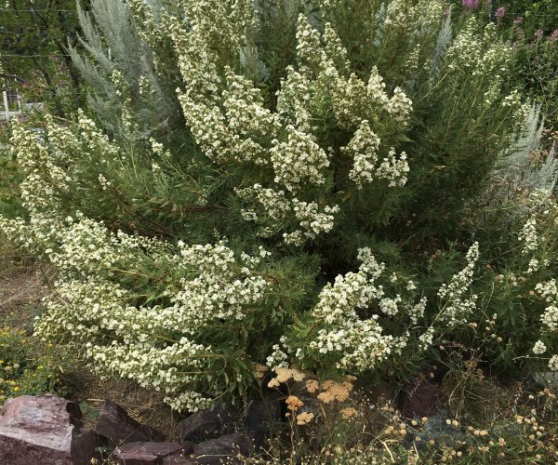Fernbush is also known by its scientific name Chamaebatiaria millefolium. It is the most valuable plant in the Southwest. The lengthy blooming season starts in mid-June and usually lasts until August. Fernbush has foliate buds, which give it the impression of being a perennial tree in the winter. The water requirement of these plants is very little once they are established in the garden. These shrubs thrive amid grasslands and cacti in their natural habitat. These plants are also used as a remedy for an upset stomach.
Fernbush is a drought-resistant perennial shrub that possesses olive-green foliage and lovely dry seed heads. It is a lovely native shrub with large clusters of bright white flowers that brighten the garden in mid-summer. It has so many beautiful characteristics that it is essential for any low-water landscape. It is a low-growing, woody shrub with a soft, rounded shape. Shearing and pruning are not a problem for these plants. These shrubs are often sheared once a year in the early winter. The name of this shrub is derived from the sharply cut and lacy patterned foliage of the fernbush.
Fernbush Propagation
Fernbush is a drought-resistant plant. It requires very little further water once it has developed itself. This characteristic is most likely due to the fernbush leaves. They are hairy and aromatic, as well as tiny and finely divided. Physical adaptations like this help the plant utilize existing water more efficiently by reducing water loss through transpiration. With its unusual appearance, fernbush is an excellent addition to the landscapes, despite its limited commercial availability.
This shrub thrives in xeric environments. This is because the white-colored flowers attract a variety of little bees and wasps, so it is best to keep them away from pathways, entrances, and other areas. In the southwest United States’ Intermountain zone, this is one of the first shrubs to leaf out in the spring. After a rain, the plant gives a really lovely fragrance.
This shrub mostly propagates through seeds. Although 3 to 4 weeks of cold-moist stratification improve germination, it is not essential. The seeds propagate in areas that are not moist or are not over-watered at the time of germination. Although rooted stem cuttings can be used to propagate fernbush, seed propagation is far more convenient. Thus, this perennial shrub is propagated easily through seeds.
Fernbush Seeds
Fernbush prefers a well-drained location, although it may grow in a variety of soil types, even those with a high pH. Fernbush seeds are linear to narrowly fusiform in shape, erect, slightly flattened at each end, and yellowish to brownish. The soft thin seedcoat’s outer layer is nicely textured, giving the seed’s body a 3-angled look; the inner layer is delicate and transparent. Fresh seeds do not go dormant, but it is important to chill the stored seeds for 1 to 3 months to make them come out of dormancy.
The sustainability of fernbush seeds can be determined in the following way:
The seeds are first steeped in room temperature water for an hour before being drained. Each seed is required to possess a horizontal slit cut across the center without being sliced in half. Seeds are then immersed for 6 hours at room temperature. The seeds are then evaluated.
Fernbush Pruning
The transplanting of fernbush is difficult and some losses are expected. The pot transplant is difficult but it is easy to transplant in the garden. Plants grow quickly, tolerate pot transplant if planted in well-drained media, and do not require excessive watering.
To eliminate old core branches, boost plant density, and improve form, it is essential to prune the plant in spring and summer. These plants are also responsive to shearing. Deep irrigation helps fernbush once or twice during the summer. A modest amount of nitrogen fertilizer can be used to energize plants, but it is rarely necessary.
The fernbush fruit is known as a follicle, and it contains very few seeds that are measured in millimeters. The wasted flower stalks are gorgeous. In the spring, they can be trimmed off to make room for new flowers and an attractive appearance.
Fernbush Care
Fernbush prefers direct sun to partial shade and well-drained soil. Light fertilizer at the time of planting aids in the establishment of the plant. It is drought resistant once developed, thorough watering regularly during hot, dry weather to keep the foliage dense is recommended to the gardeners.
Fernbush is a low-maintenance shrub, it does not require any hard or difficult to manage the environment for its growth. The gardeners are required to grow these shrubs in a dry or in the areas that are directly exposed to the sunlight.



